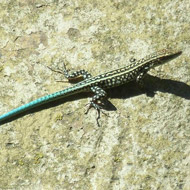Like many species, lizards use bright colours to attract females.
More likely to fall prey to bird attacks
Male lizards are more likely to be attacked by predators than females because of the bright colours they use to attract a mate, according to a study by the University of Cambridge.
Like many species, lizards use bright colours to attract females and intimidate male rivals. Now a new study, published in the journal Ecology and Evolution, has provided evidence that this signalling comes at a cost.
In the study, replica models of male and female wall lizards found on the Greek islands of Skopelos and Syros were used to see whether natural selection favours camouflage, and whether the lizard's need to have bright sexual signals might impair its effectiveness.
They found that the male lizards were less well camouflaged against their habitat and are more likely to fall prey to bird attacks.
Marshall, lead author of the study, said: “It has previously been assumed that conspicuous male colours are costly to survival, but this hasn’t been tested before among these specific lizards living on different islands, and in general rarely in a way that takes into account the particular sensitivities of avian vision.”
Birds are able to see ultraviolet light, which means that they can perceive colour (and camouflage) in a very different way to humans. To see if males really are more visible to birds, the researchers developed models which accurately replicated the lizard's colour to a birds' eye.
The models were placed around ten sites on each of the two islands and were checked every 24 hours over five days to see which had been attacked by birds.
“The models that had been attacked showed signs of beak marks, particularly around the head, and some had been decapitated,” explains Marshall. “We even found a few heads in different fields to the bodies.”
“The fact that the birds focused their attacks on the heads of the models also shows us that they perceived them as real lizards because that is how they would attack real prey,” she adds.
At the end of the study the researchers found that the models with male colouration had been attacked more then the models with female colouration.
The team now wish to investigate how patterns of colour affect survival rates.
"It would also be great to apply this type of experiment to other questions, such as how different environments affect the amount of predation that prey animals experience," Marshall adds.
Image (C) Notafly/Wikimedia







 Birmingham Dogs Home has issued an urgent winter appeal as it faces more challenges over the Christmas period.
Birmingham Dogs Home has issued an urgent winter appeal as it faces more challenges over the Christmas period.
